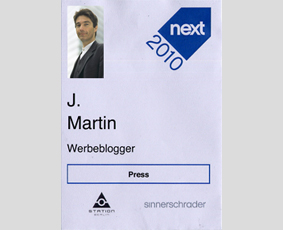On Stowe Boyd’s presentation “Social Media Blur: Blogs, Networks, Streams” at the Next10 Conference in Berlin, May 11–12, 2010.
Die deutsche Version dieses Eintrags gibt es drüben beim Werbeblogger [RIP].
All #Next10 posts at between drafts are here.
The gist of Stowe Boyd’s presentation at the Next10 conference can be summarized as follows. What we think of as Social Media is constituted by different media and different channels, this much is obvious, but there have been three distinct phases so far of actual social media channels and how media got “socialized” the historicity of which we often fail to notice—hence The Social Media Blur as the title of his presentation.
Here it is:
The first phase, by the end of the nineties, was initiated by blogs, written by a “couple hundred people,” often labeled “fringe lunatics” (and worse) by the mainstream media. This phase, and that was not at all obvious at the time, was going to have an enormous impact, but this impact was delayed. Also, blogs really aren’t all that “social”; all things considered, they’re better described with their former label “personal publishing.” But blogs had a huge impact toward the “democratization” of the media and the shift in people’s perception about what constitutes social discourse. Toward and from every direction: Boyd’s example is the New York Times where it’s become increasingly nonsensical to differentiate between “articles” or “blog entries” in the online edition.
The second phase was the rise of social networks. Which seem already ubiquitous to us, and whose graphs in terms of participation indeed seem set to approach actual ubiquity. When Boyd says that tweens are “connected almost every waking minute of their day” through social networks, he might have the NYT article “If Your Kids Are Awake, They’re Probably Online” in mind. But despite their enormous numbers of participants, these networks are still made up of personal relationships and still “based on social scale” instead of organizations broadcasting to people, and that’s where this phase stands out in terms of “social.”
The third phase is what Boyd calls “the rise of streams”: microstreaming, microblogging, mini-feeds, and complete services like Twitter which do nothing but. Their major impact in terms of social discourse and how we perceive information is the “open model,” i.e., the asymmetric follower model, which has replaced RSS feeds as the primary means for accessing information in only a few years. It has a major impact on how new businesses are working and on the “rise of social television”—where people not only watch and tweet about sporting events in real time, but the entertainment industry tries to loop these feeds back into their networks. And, of course, it has a major impact on how we affiliate and how we create identity.
And there are two recent developments which will take this even further. The first are streaming apps that increasingly integrate and resolve information (images, videos, newspaper articles, etc.) within the stream into what Boyd calls a “Web of Flow” where everything is “pulverized” through the speed of the stream, with an archive layer beneath.
The second development is that all this, again, is in the process of being integrated into hardware and software in such a way that most of these streams soon won’t be delivered through “devices” or “applications” anymore but be as fully und fundamentally integrated into our hardware and software environments “as the Finder on Apple computers.”
People who attend enough meetings and conferences often voice their misgivings that they meet the same speakers again and again, but that certain speakers get invited again and again often happens for a reason. None of what Stowe Boyd talked about in his presentation is essentially “new,” but it’s the perspective that is most valuable here. If you start to unravel the “lost history” of Social Media, vertigo sets in, or at least it should set in. This all happened within a time frame of about ten years. And not only is it just the beginning, we’re still accelerating, and on a massive scale, and even this acceleration is accelerating. Moreover, “integration”—as it does in computer architecture—not only integrates elements, it also adds abstraction layers to our social and mental environments which have a profound impact, again, on how we operate in the social space and how we create identity.
But this accelerating acceleration might not be the only problem we have, and maybe not even our most important one. On the one hand, there are these tremendous attempts on a global scale, corporate, politically, legally, toward mounting a “Restauration” with the potential to tear everything apart and pulverize much more than just pieces of information—think of it as stepping with exponentially increasing force on your brake and your gas pedal at the same time. On the other hand, it has been observed that our fundamental modes of communication seem to resist these changes, being increasingly at odds with our rapidly evolving means of communication.
It becomes progressively likely right now that we will approach the answer to the question “Where do we go from here?” only through an ever escalating run & tumble motion.
If you have something valuable to add or some interesting point to discuss, I’ll be looking forward to meeting you at Mastodon!

